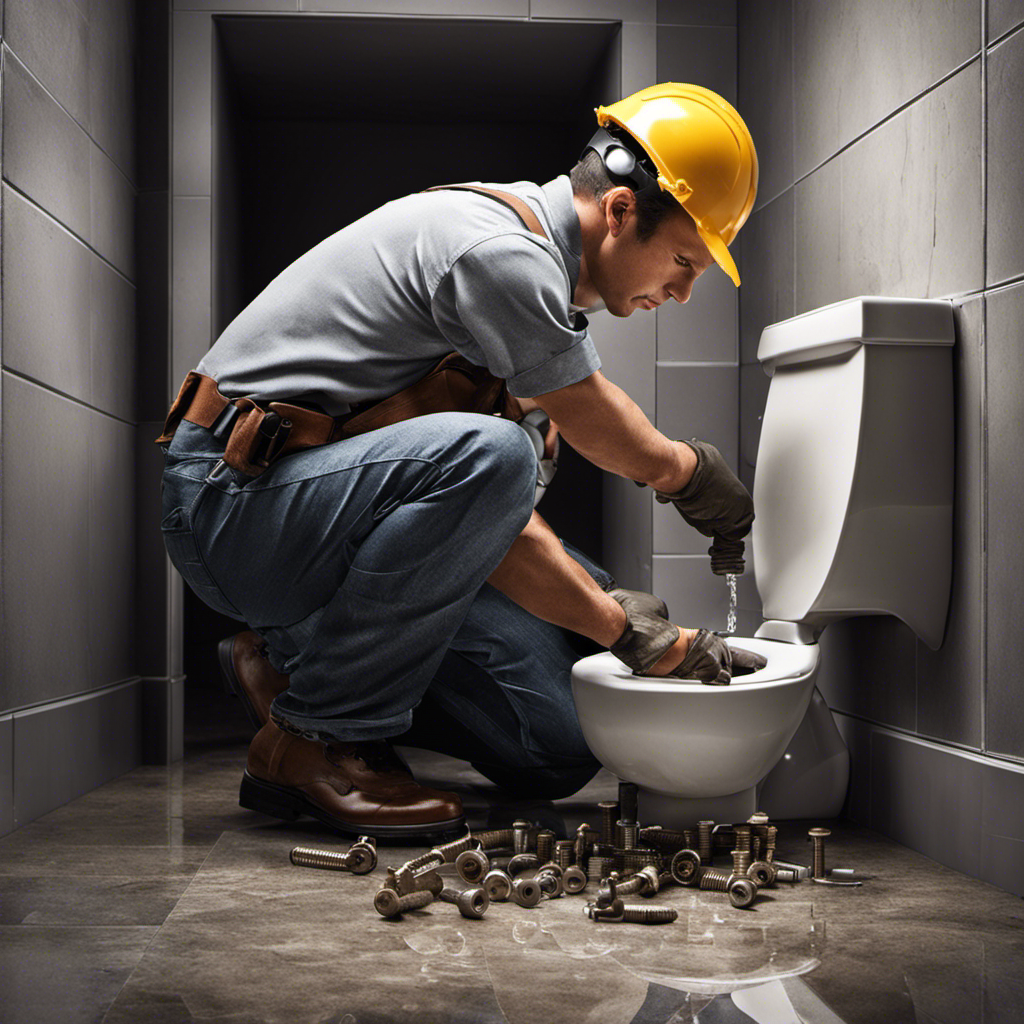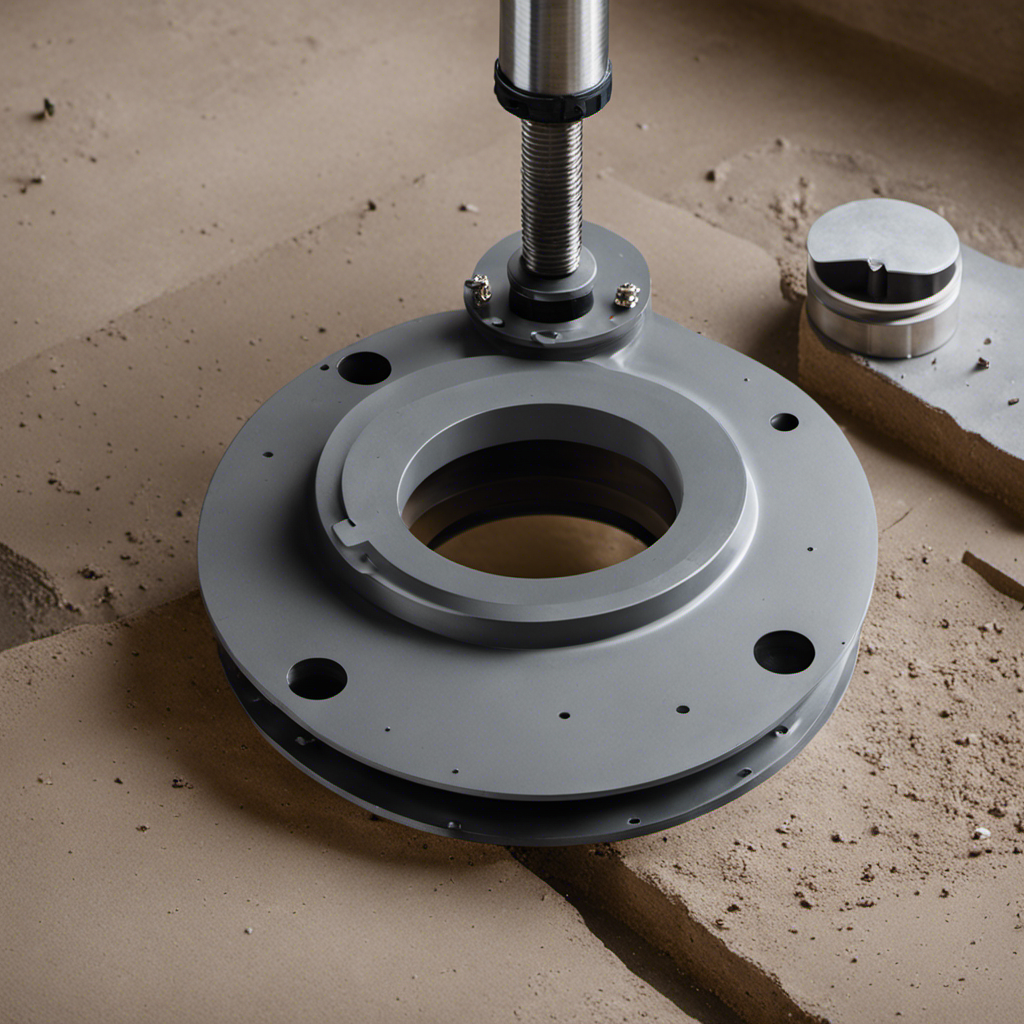Did you know that a leaking toilet from the base can waste up to 200 gallons of water per day?
As someone who has dealt with this frustrating issue before, I understand the importance of finding simple fixes to repair these leaks and prevent future ones.
In this article, I will share my knowledge and provide step-by-step instructions on how to fix loose tee bolts, damaged wax rings, and loose water supply lines.
Additionally, I will offer valuable prevention tips to keep your toilet leak-free.
Let’s dive in and tackle this problem together.
Key Takeaways
- Loose tee bolts and damaged wax rings are common causes of toilet leaks from the base.
- When fixing loose tee bolts, ensure they are tightened securely without overtightening to prevent water leakage onto the floor.
- To fix a damaged wax ring, turn off the water supply, remove the toilet, and scrape away the old wax before replacing it.
- To prevent toilet leaks, stay vigilant for signs of a leak, conduct regular checks, use food coloring to detect leaks, and consider installing a leak detection device to avoid water damage and unnecessary expenses.
Causes of Toilet Leaks From the Base
The causes of toilet leaks from the base include loose tee bolts, a damaged wax ring, a loose water supply line, condensation, and flushing unnecessary objects.
When checking for condensation, it’s important to ensure that the toilet tank is not sweating. This can be done by wiping the surfaces dry and monitoring for any moisture buildup.
To fix loose tee bolts, gather the necessary tools and tighten them securely.
If the wax ring is damaged, it needs to be replaced. Start by detaching the toilet, then scrape away the old wax and install a new wax ring.
For a loose water supply line, inspect the rubber and nut for any faults. Tighten or replace them accordingly and reconnect the water supply line.
Fixing Loose Tee Bolts
To fix loose tee bolts, I need to gather the necessary tools and then check for condensation.
Tee bolt maintenance is crucial in preventing future leaks from the base of the toilet.
First, I gather a wrench and a screwdriver to tighten the bolts.
Before tightening, I inspect the area for any signs of condensation, as this can indicate a larger issue.
If condensation is present, I wipe it away and ensure the area is dry before proceeding.
Carefully, I tighten the tee bolts, making sure not to overtighten and damage the toilet.
This simple fix can help secure the base and prevent water from leaking onto the floor.
Fixing a Damaged Wax Ring
When fixing a damaged wax ring, I gather the necessary tools and check for any signs of condensation. This is important because condensation can indicate a larger issue that needs to be addressed.
Once I have confirmed that there is no condensation, I proceed with the following step-by-step instructions for replacing the wax ring:
-
Turn off the water supply: Before beginning any work, it is crucial to shut off the water supply to the toilet to prevent any leaks or spills.
-
Remove the toilet: Carefully detach the toilet from the floor by loosening the bolts and disconnecting the water supply line. Place the toilet aside on a towel or cloth to protect the floor.
-
Scrape away old wax: Gently scrape away the old wax ring from both the toilet flange and the toilet base using a putty knife or scraper. Be thorough in removing all remnants of the old wax.
-
Install the new wax ring: Place the new wax ring onto the toilet flange, ensuring that it is centered and properly aligned. Carefully lower the toilet onto the wax ring, applying even pressure to create a tight seal.
Replacing the wax ring is necessary when there are common signs of a damaged wax ring, such as water leaks around the base of the toilet, foul odors, or visible deterioration of the wax ring.
Fixing a Loose Water Supply Line
After gathering the necessary tools and checking for condensation, I inspect the rubber and nut of the loose water supply line to determine if they need tightening or replacing.
Inspecting rubber parts is crucial as they can degrade over time, leading to leaks. I carefully examine the rubber for any signs of cracks, tears, or deterioration. If I find any faults, I replace the rubber with a new one to ensure a tight seal.
Similarly, I inspect the nut to ensure it is securely fastened. If the nut is loose or damaged, I replace it with a new one to prevent any water leakage.
Tips to Avoid Toilet Leaks
I regularly inspect and maintain my toilet to ensure it remains leak-free. Preventing toilet leaks is crucial to avoid water damage and unnecessary expenses. Here are three important tips to detect and prevent water leaks in a toilet:
-
Stay vigilant for common signs of a toilet leak, such as a constantly running toilet, a noticeable increase in water bills, or water pooling around the base of the toilet. These signs indicate a potential leak that needs immediate attention.
-
Conduct regular checks to detect water leaks in a toilet. Start by adding a few drops of food coloring to the toilet tank and wait for about 15 minutes. If the color appears in the toilet bowl without flushing, there is a leak in the flapper valve that needs to be fixed.
-
Consider installing a leak detection device that can alert you to any water leaks in the toilet. These devices can provide early warnings and help prevent extensive water damage.
Frequently Asked Questions
Can a Leaking Toilet Base Cause Water Damage to the Floor or Surrounding Areas?
Yes, a leaking toilet base can cause water damage to the floor and surrounding areas. Common signs of water damage include warped flooring, stains, and mold growth. Preventing water damage is crucial by fixing the leak promptly and ensuring proper maintenance.
How Can I Tell if the Wax Ring Needs to Be Replaced?
To determine if the wax ring needs replacing, look for signs like water pooling around the base, unpleasant odors, or a wobbly toilet. If any of these occur, it’s time for a new wax ring.
Is It Possible to Fix a Loose Water Supply Line Without Detaching the Toilet?
Yes, it is possible to fix a loose water supply line without detaching the toilet. To do so, gather necessary tools, check for condensation, inspect rubber and nut, tighten or replace faulty parts, and reconnect the water supply line.
Are There Any Home Remedies or DIY Solutions to Fix a Leaking Toilet Base?
Sure, there are some DIY solutions for fixing a leaking toilet base. You can try tightening the tee bolts, replacing the damaged wax ring, or fixing a loose water supply line. However, for more serious issues, it’s best to seek professional help. As for prevention tips, avoid flushing unnecessary objects and regularly inspect and maintain the toilet to prevent leaks.
Can a Leaking Toilet Base Lead to an Increase in Water Bills?
Yes, a leaking toilet base can lead to an increase in water bills and potential floor damage. It is crucial to address the issue promptly to avoid further expenses and potential water damage.
Conclusion
In conclusion, fixing a leaking toilet from the base is a simple task that can be done with a few basic tools and some handy tips. By tightening loose tee bolts, replacing a damaged wax ring, or fixing a loose water supply line, you can easily resolve the issue.
Remember to regularly inspect and maintain your toilet to prevent future leaks. As the old saying goes, ‘A stitch in time saves nine.’ So, don’t delay in fixing leaks and seek professional help if needed.
Stay proactive and keep your toilet in tip-top shape.










